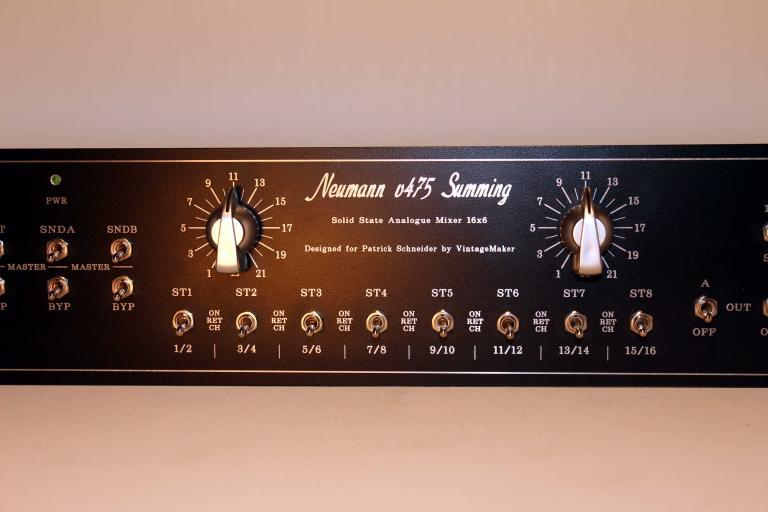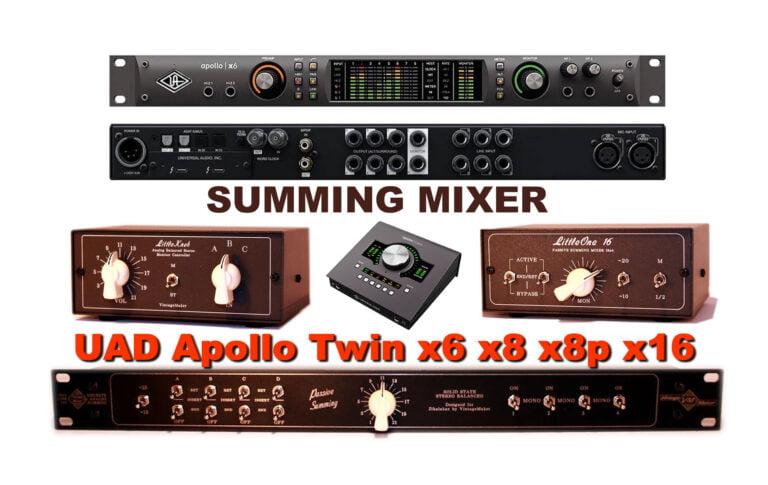Studio review from Switzerland Vintage Maker 16 Channel active Summing Mixer with a v475-2C Neumann Amp
Summing Mixer Review
Patrick Schneider – Composer – Switzerland
Since 2020 I’m using a Vintage Maker 16 Channel active Summing Mixer with a v475-2C Neumann Amp.
My new Monitoring Controller is a Little MC 2×2.
DAW:
For many years I was composing and demo mixing all tracks in a Box with an active Monitoring. After
working with Producers in Los Angeles using SSL Consoles, I was convinced to re-design my
compositing environment for analogue Summing.
- Patrick Schneider music studio
- Patrick Schneider studio
One big challenge was to find an affordable and good sounding 16 Channel D/A and a very good recording A/D. Many discussions with local Mastering Engineers (using Mytek) as well as having studied many D/A and A/D specifications finally ended up to buy RME FF800 and FF400 (Main A/D). Each 8 Channel Converter Unit is connected through a separate FireWire 800 PCIe Card to provide the full 192kHz bandwidth. Now Ableton with ASIO4ALL and TotalMix are running with 16 Channels@192kHz over WordClock synchronization. I could run my legacy AES and SPDIF Equipment over the RME Slave Unit, using the “single speed” WordClock Option to sync 48kHz Signals. Against all Experts I could sync 192kHz and 48kHz Signals within the same Vintage Maker setup.
- stereo channel insert mixer
- Dual Stereo Stereo balanced
The Vintage Maker Neumann Amp End-to-End RMS noise floor was measured with a value of 102dB RMS (DigiCheck – Flat filtered for 22kHz@192kHz, all VM Insert’s inactive). All RME Input and Output Signals are set to Output Hi Gain, Input Low Gain for +19dBu@0dBfs Levels.
Cabling, Monitoring:
I cabled the D/A’s with Contrik/Neutrik Cables NK2/4. For most Insert’s, Main out and FF400 A/D In I use my expensive Silver Mic Cables from the 70’s. I did some check’s between cables and could clearly hear some differences. Maybe due to the fact, that I also moved away from an active Monitoring to a full Class-A Bi-wired passive Monitoring using a H&H VX 450 Watt MosFET Amp with Tannoy System 12 DMT Speakers.
- Cabling: I cabled the D/A’s with Contrik/Neutrik Cables NK2/4.
As a controller I bought the Vintage Maker Little MC2x2. For the Room Equalization I’m using a Klark DN 360 with a Pikatron Transformer Option. The new Monitoring makes a big and important difference.
- LittleMc2x2 Desktop Studio Monitor Controller
Composing:
Once a track or a session is partially composed, I start to record the Instrument Signal directly into RME FF400 3&4 (Instruments) or 1&2 (Mic Levels). I never record through my Mackie Live Mixers. Those are only used during session work and Headphone sub Mix. Mainly the record signal goes through the new Vintage Maker in active Neumann Mode with or without Insert’s for additional signal attack coloring (Outboard coloring Equipment like Studer, Urei, Klark, BSS etc …). It’s amazing how spectral elastic the recorded signals are with Vintage Maker. Vintage Maker Signals often make post editing more flexible and sound great. During Demo Mixing I run each Channel over Ableton Send (12 Mono Sends possible), RME TotalMix D/A Chip Routing through Vintage Maker.
The v475-2C sounds very fat, transparent, colorful, and the release energy is great.
Mono sounds very good as well. Handling with the switches is excellent for Coloring comparison and enabling disabling.
I’m still learning how to use the new Vintage Maker capabilities like Mono Features and Insert’s.
An Example could be:
1-4 with Mono Option > BassDrum, Main Vocal, SubBass
5-6 Percussion’s
7-8 Bass
9-10 Synthesizer
11-12 Backing Vocal’s
13-14 Violin, Guitars, Lead Instruments
15-16 Effect Samples
Thanks to Vintage Maker
Greetings from Switzerland – Patrick and Claudia.
- Patrick and Claudia.
















